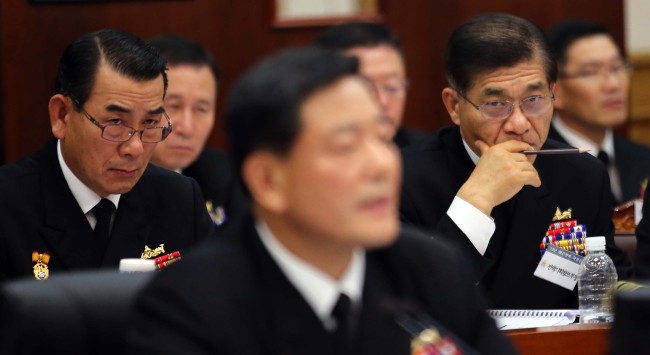 |
Senior Navy officers look on as Chief of Naval Operations Adm. Hwang Ki-chul (center) is grilled by lawmakers over the controversial construction of a strategic naval base on Jeju during a parliamentary audit in the Gyeryongdae military headquarters in South Chungcheong Province on Wednesday. (Yonhap News) |
South Korea is seeking to acquire radars capable of detecting stealth aircraft by the 2020s as neighboring states such as China and Japan are pushing to deploy radar-evading warplanes in pursuit of air superiority.
“The Air Force made the request to procure stealth detecting radars in July 2011 and the Joint Chiefs of Staff decided last November to procure it as part of the long-term acquisition plans,” a military source said, declining to be named.
“We have decided to determine whether to develop it domestically or purchase it from overseas, after conducting a feasibility study.”
Seoul is also considering purchasing stealth aircraft through its high-profile fighter procurement project. The government has recently decided to start the project from scratch amid criticism that it focused more on budgetary constraints than on broader national strategic interests.
The efforts to acquire stealth capabilities came as China, Japan and Russia have strived to acquire stealth combat aircraft.
China is trying to develop fifth-generation radar-evading aircraft such as the J-20 and J-31 while Japan has signed a contract with Lockheed Martin to purchase 42 F-35 jets. Russia is working on building its own T-50 stealth fighter with the goal of deploying it in 2016.
In its report offered during a parliamentary audit of the administration, the Air Force said that due to delays in the next-generation fighter procurement project and another to develop indigenous warplanes, the Air Force would fall short of some 80 warplanes in 2019 when most of its aging F-4s and F-5s will be decommissioned.
Meanwhile, the Navy is moving to bolster maritime defense with plans to install advanced radars on its patrol ships and acquire more Aegis-equipped destroyers and submarines, officials said Wednesday.
These moves come as North Korea continues to remain a destabilizing factor near the western sea border and neighboring states such as China and Japan push to increase their naval clout with aircraft carriers and other high-tech weapons systems.
The Navy plans to install advanced indigenous radars on 15 new 1,200-ton corvettes by 2015. It also pushes to increase the number of 7,600-ton Aegis destroyers from the current three to six to better handle North Korean and other potential regional threats.
During a parliamentary audit of the government, New Chief of Naval Operations Adm. Hwang Ki-chul expressed his will to secure additional Aegis warships at an earlier date. Last November, the Navy made the request to the Joint Chiefs of Staff to deploy additional Aegis warships in the early 2020s.
To enhance underwater operations and longer-range precision strike capabilities, the Navy also seeks to deploy nine 3,000-ton submarines in the 2020s. It also plans to procure six additional 5,900-ton destroyers after 2023 and some 20 2,300-ton frigates by 2026.
Meanwhile, during a parliamentary audit of the government, Rep. Chung Hee-soo of the ruling Saenuri Party claimed that naval operations had frequently been impeded by breakdowns of its core warships, submarines and aircraft.
According to the Navy data submitted to the lawmaker, between June 2010 and June this year, Aegis destroyers went out of order twice, its destroyers 34 times, its surveillance aircraft 42 times and its choppers 24 times.
Also at the audit, Saenuri Rep. Song Young-keun claimed that the Air Force has not received sufficient warranty service from the U.S. defense giant Boeing for problems that occurred during its operation of four E-737 Peace Eye early warning aircraft.
By Song Sang-ho (
sshluck@heraldcorp.com)





![[Exclusive] Hyundai Mobis eyes closer ties with BYD](http://res.heraldm.com/phpwas/restmb_idxmake.php?idx=644&simg=/content/image/2024/11/25/20241125050044_0.jpg)

![[Herald Review] 'Gangnam B-Side' combines social realism with masterful suspense, performance](http://res.heraldm.com/phpwas/restmb_idxmake.php?idx=644&simg=/content/image/2024/11/25/20241125050072_0.jpg)
